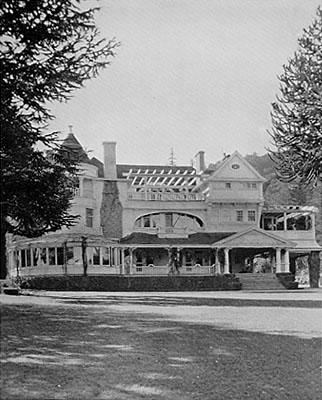 |
||
|
|
|
|
 |
|||||||||||||||||||||||||||||||
|
THE WAY IT WAS Lavish memories of the Schilling estate where spice merchant August Schilling built a fairy land By Marion Softky
|
|||||||||||||||||||||||||||||||
 |
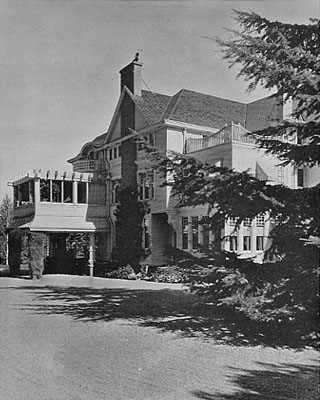 |
|
|
|
Half a dozen greenhouses and a couple of conservatories fed Mr. Schilling's passion for flowers. Water cascaded down waterfalls fashioned from artificial rocks abloom with color. There was a deer park, several lakes and waterworks, a 32-room guest house in a converted winery, a swimming pool with more sculptured rocks, a garage for five cars, and a farm with vegetable garden, livestock and orchards.
 |
 |
|
|
|
The present August Schilling of Woodside remembers: "Grandfather credited the good Lord with inventing redwood trees and big oaks. The rest was trash created by Satan and could be eliminated."
And clear the "trash" he did. The result was a carefully manicured park that ran up the hill through the redwood forest as far as La Honda Road. Trail and auto roads led visitors to a cottage with a bonfire site, a lake with an artificial island, trout ponds, a redwood temple with fountain, meditation groves with benches, a pergola and amphitheater. The forest floor was banked with ferns, cyclamen, rhododendron and camellias, Mr. Skrabo remembers. And there was even a Rock of Ages and an Inspiration Point
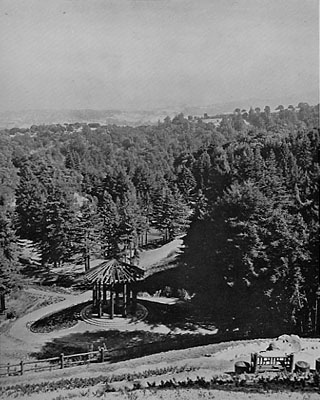 |
 |
|
|
|
A crew of 50 to 60 gardeners nursed the plants and kept the grounds immaculate. Every time a leaf fell, someone had to pick it up, one gardener recalled.
Today, 60 years after August Schilling’s death, his treasured estate has mostly returned to nature, broken up among several owners and the Mid-peninsula Regional Open Space District. The underbrush he so strenuously conquered chokes the vistas.
But the visitor driving up Old La Honda Road or hiking into the Thornewood Open Space Preserve can still catch glimpses of what was once August Schilling’s wonderland.
From Schilling Lake, now overgrown with cattails, one can look up long slopes to the base of the redwood temple and even farther up to the site of the pergola. Here and there among the woods are some of the artificial rocks crafted by Italian artisans from pipe, wire mesh and cement.
The easiest place to get a look at the faux rocks is at the bridge on Old La Honda Road near its intersection with Portola Road. Here the rocks, many with weed filled cavities where flowers were planted, still surround the bridge.
From there, Mr. Skrabo recalls, you could see up the creek cascade, landscaped with flowers, to the waterfall and the deer park above. "The focal point and most beautiful part was the waterfall," he says.
The story of August Schilling and his estate can be pieced together from memories of the present August Schilling, Mr. Skrabo, and other Schillings who still live in the area. Sewall "Skip" Bogart of Portola Valley wrote a comprehensive history of the estate in a 1977 issue of "La Peninsula," the magazine of the San Mateo County Historical Association. In addition, August Schilling recorded views of the estate in a book, "Portola Hall-Hills," privately published in 1926.
The beginning
"Grandfather and his brother received a present from their father of two one-way tickets to New Orleans," says August Schilling in the living room of the home he built on the Woodside estate of his father, Rudolph Schilling.
 |
|
|
After he arrived in this country at age 16—about 1870—young August found his way to San Francisco, where he got into the coffee business. Initially he went into partnership with coffee-magnate James Folger, Mr. Schilling says.
Coffee led to tea, baking soda and spices, and in 1881 he founded the famous spice house of A. Schilling and Co. with a partner, George F. Volkmann. Schilling spices, now owned by McCormick & Co. Inc., still appear on grocery store shelves today.
According to some accounts, Mr. Schilling was a very progressive businessman, with a taste for poetry. He is said to have been one of the first to give employees an hour off for lunch. Office doors were locked, and workers were inspired by the poem, "A time for work; A time to rest; A time to eat; your lunch with zest"
The present Mr. Schilling notes that there was "a degree of rivalry" between his grandfather and James Folger. Perhaps that is what prompted Mr. Schilling to buy a summer home in Woodside near the one that Folger built - which now belongs to computer - game pioneer Nolan Bushnell.
In any case, Mr. Schilling eyed the mansion built about 1881 by San Francisco attorney Edgar F. Preston. Mr. Preston had sold his considerable holdings to San Francisco land speculator Juhian Thorne, who divided them into 6-and 8-acre parcels and tried to peddle them.
 |
|
|
Possibly wanting to one-up Mr. Folger, Mr. Schilling was forced to enlist business associates and relatives to bargain for various parcels. By 1914 he had accumulated 150 acres, to which he added through the years, Mr. Bogart reports.
The hillsides he acquired were originally logged by pioneer Irishman Dennis Martin, who had created the reservoir, now called "Schilling Lake," to power one of two sawmills along Dennis Martin Creek.
Mr. Schilling eventually bought land extending from the valley floor east of Portola Road up the canyon as far as La Honda Road. It included the four-story mansion with a turret and 10 fireplaces, which he renamed Portola Hall; Preston’s Monte Bello Winery, which was converted to the guesthouse named Sunny Run; and vineyards.
Mr. Schilling immediately launched his major effort to rebuild the mansion and recreate the mountain according to his dream.
 |
 |
|
|
|
The heyday
Young John Skrabo remembers picking eight or nine dozen gardenias at a time for a centerpiece for the Schilling table. Every month gardeners would move a hundred potted plants to the conservatories.
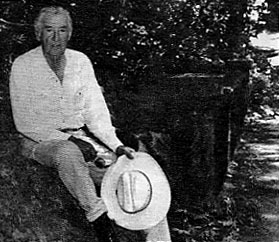 |
|
|
The three years he worked in August Schilling’s greenhouses left an indelible impression on a teenager born in Hell’s Kitchen in New York City. John Skrabo was the son of one of the Croatian families that began migrating to Portola Valley at the turn of the century and worked the great estates springing up around Portola Valley and Woodside.
John dropped out of Sequoia High School as a junior in 1928, when his father injured his back and couldn’t work. Chester Skrabo had built much of the stonework in Portola Valley, including the heartshaped planter at the entrance to the Schilling gardens. Then it was planted in flowers; now it’s trees.
John started working for the generous sum of 50 cents an hour — much better than the 40 cents other landowners were paying, he notes. Later be was hired full time for $100 a week.
 |
|
|
Mr. Schilling loved nature; he used to walk around the estate twice a day. "I could smell him coming; he smoked the greatest cigars in the world," Mr. Skrabo remembers. "He reminded me of Kaiser Wilhelm. He always spoke to you."
The present Mr. Schilling and Mr. Skrabo both remember the deer park at the top of the hill above the waterfall. Andrew Jurian, another of the Croatians, took care of some 50 mule deer imported from Nevada, Mr. Skrabo reports. Every morning and every afternoon at 4 p.m. he would blow a bugle and the deer would all come over to enjoy carrots and rolled oats.
Mr. Schilling remembers that some of the deer escaped. (He believes they jumped the fence; Mr. Skrabo says some "outlaw hunters" from Woodside cut the fence to poach deer.) "The state fish and game (department) forced the slaughter of the deer because they were not indigenous," he says.
Above the deer park, Mr. Skrabo remembers a 2-acre plot planted with red, white and blue flowers in the pattern of an American flag.
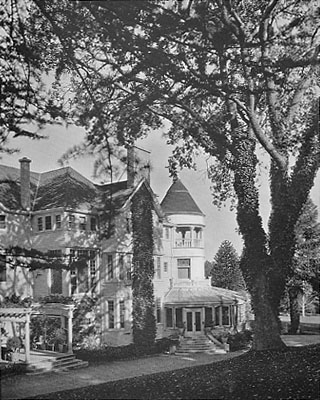 |
|
|
Both men remember the 70-foot row of gardenias. At the time the younger Mr. Schilling had a girlfriend who loved gardenias. He remembers he was able to "sneak enough" to keep her in fragrant corsages.
Young August also loved to swim in the pool surrounded by the hollow rocks. "They had a fascinating ring if you tapped them," he recalls.
With all his accommodations and activities, old Mr. Schilling apparently loved to entertain relatives, friends, business associates and even scout troops. The San Mateo County Historical Society has a huge group photograph, 1 foot by 4 feet, which shows some 150 people lined up in front of the mansion. The picture, probably of a company picnic, was labeled April26, 1925, and accompanied by an inspirational poem.
 |
|
|
After Mr. Schilling suffered a stroke about 1929, he built another conservatory, called "Sunny Life," with a high ceiling and a road through it, Mr. Skrabo recalls. Then he’d drive around the property and through the conservatory twice a day in his Ford Phaeton.
Today’s Mr. Schilling recalls that the old man had an elaborate walker constructed out of pipes so he could get around on flat surfaces.
Even before Mr. Schilling died at 80 in 1934, the estate began to go downhill. After his death, the house was more or less abandoned, and his heirs began selling off the land. "When Mr. Schilling died, it seemed that everything died with him," Mr. Skrabo says.
The mansion lasted until 1952, when it was sold and demolished as a fire hazard. "It was an absolute nuisance," says the present Mr. Schilling.
On Jan. 10,1953, the Redwood City Tribune chronicled its last ordeal: the battle of the bees. It seems half a dozen hives had made their home in the old house. The gallant critters fought a valiant rear-guard action against the new owners, the wreckers and assorted chemicals. But in the end, after almost six months, the house came down, mighty beams, rock walls, fireplaces and all.
The article by Michael Kernan concludes, "Even the bees have gone away."
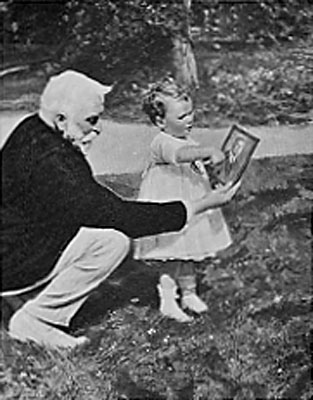 |
|
with Virginia, the granddaughter of his partner, George Volkman. |
